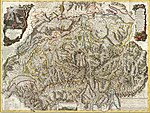
Back Alte Eidgenossenschaft ALS الاتحاد السويسري القديم Arabic Antigua Confederación Suiza AST Qədim İsveçrə İttifaqı Azerbaijani Швейцарскі саюз Byelorussian ওল্ড সুইস কনফেডারেসি Bengali/Bangla Antiga Confederació Suïssa Catalan Stará švýcarská konfederace Czech Gamle schweiziske edsforbund Danish Alte Eidgenossenschaft German
Swiss Confederacy | |
|---|---|
| 1291–1798 | |
 | |
| Capital | None[4] |
| Official languages | German[5] |
| Common languages | [citation needed] |
| Religion | Roman Catholic Continental Reformed |
| Demonym(s) | Swiss |
| Government | Confederation |
| Legislature | Tagsatzung |
| History | |
• Death of Rudolf I | 15 July 1291 |
| 1 August 1291 | |
| 1356 | |
| 13–14 September 1515 | |
| 1529 and 1531 | |
• Formal independence from the HRE | 15 May/24 October 1648 |
| January–June 1653 | |
• Collapse | 5 March 1798 |
| Currency | About 75 different local currencies, including Basel thaler, Berne thaler, Fribourg gulden, Geneva thaler, Geneva genevoise, Luzern gulden, Neuchâtel gulden, St. Gallen thaler, Schwyz gulden, Solothurn thaler, Valais thaler, Zürich thaler |
| Today part of | Switzerland |
| History of Switzerland |
|---|
 |
| Early history |
| Old Swiss Confederacy |
|
| Transitional period |
|
| Modern history |
|
| Timeline |
| Topical |
|
|
The Old Swiss Confederacy, also known as Switzerland or the Swiss Confederacy,[6] was a loose confederation of independent small states (cantons, German Orte or Stände[7]), initially within the Holy Roman Empire. It is the precursor of the modern state of Switzerland.
It formed at the end of the 13th century, from a nucleus in what is now Central Switzerland, expanding to include the cities of Zurich and Bern by the middle of the 14th century. This formed a rare union of rural and urban communes, all of which enjoyed imperial immediacy in the Holy Roman Empire.
This confederation of eight cantons (Acht Orte) was politically and militarily successful for more than a century, culminating in the Burgundy Wars of the 1470s which established it as a power in the complicated political landscape dominated by France and the Habsburgs. Its success resulted in the addition of more confederates, increasing the number of cantons to thirteen (Dreizehn Orte) by 1513. The confederacy pledged neutrality in 1647 (under the threat of the Thirty Years' War), although many Swiss served privately as mercenaries in the Italian Wars and during the early modern period.
After the Swabian War of 1499 the confederacy was a de facto independent state throughout the early modern period, although still nominally part of the Holy Roman Empire until 1648 when the Treaty of Westphalia ended the Thirty Years' War. The Swiss Reformation divided the confederates into Reformed and Catholic parties, resulting in internal conflict from the 16th to the 18th centuries; as a result, the federal diet (Tagsatzung) was often paralysed by hostility between the factions. The Swiss Confederacy fell to a French invasion in 1798, after which it became the short-lived Helvetic Republic.
- ^ Corpus helveticum, in the Historical Dictionary of Switzerland.
- ^ Corps helvétique, in the Historical Dictionary of Switzerland.
- ^ a b Corpo helvetico, in the Historical Dictionary of Switzerland.
- ^ Kaufmann, David (2018). "4. Bern: the government city". Varieties of Capital Cities. Edward Elgar Publishing. ISBN 978-1788116435.
- ^ Ayres-Bennett, Wendy; Carruthers, Janice (2018). Manual of Romance Sociolinguistics. De Gruyter. p. 529. ISBN 978-3110365955.
- ^ (Modern German: Alte Eidgenossenschaft; historically Eidgenossenschaft, after the Reformation also Corps des Suisses, Confoederatio helvetica "Confederation of the Swiss")
- ^ In the charters of the 14th century described as "communities" (communitas hominum, Lantlüte), the German term Orte becomes common in the early 15th century, used alongside Stand "estate" after the Reformation. The French term canton is used in Fribourg in 1475, and after 1490 is increasingly used in French and Italian documents. It only enters occasional German usage after 1648, and only gains official status as synonym of Stand with the Act of Mediation of 1803. Kantone in German, French and Italian in the online Historical Dictionary of Switzerland, 2016.

